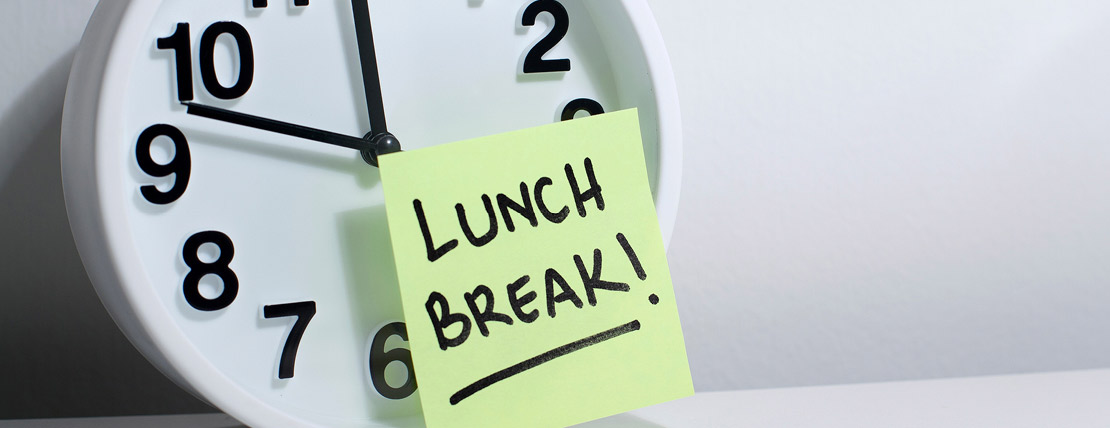For WorldatWork Members
- Wellness Woes: Why Aren’t Employees Using Your Benefits? Workspan Daily Plus+ article
- Tracking Your Employees? Make Sure You’re Not Breaking Any Rules, Workspan Daily Plus+ article
- Total Rewards Inventory of Programs & Practices, research
- Total Rewards Model: A Guide, tool
For Everyone
- Is the Lunch Break as an Employee Benefit … Broken? Workspan Daily article
- The High Cost of Burnout for Employees and Employers, Workspan Daily article
- How Workplace Surveillance Impacts Job Performance, Workspan Daily article
- Wage-and-Hour Compliance: You Are Either Fine or Fined, Workspan Daily article
It’s no surprise that few people take regular lunch breaks today, but recently coined terms like “hanger” and “lunch guilt” cast light on the impact this trend is having on workplace well-being, culture and productivity.
According to a study released in September by ezCater, a provider of flexible employee meal programs, 84% of surveyed workers deal with “hanger” — the anger, frustration and lack of focus that comes from being hungry at work. The problem is even more acute for Generation Z workers, who are more than twice as likely as older peers to feel like it’s hard to step away from their desks and take a lunch break.
“That’s a red flag for productivity and culture,” said Robert Kaskel, ezCater’s vice president of people. “Employers need to think about lunch not as a period of downtime but as a vital opportunity to reinforce the employee value proposition.”
Ensuring lunch breaks can offer a chance for employees to meet and engage. It also may be a legal requirement: About half of U.S. states mandate that employers provide meal or other paid breaks.
Access a bonus Workspan Daily Plus+ article on this subject:
The Evolving Lunch Break
Such breaks have long been considered both a benefit and workplace perk, one that has ebbed and flowed over the decades, according to Megan Elias, an associate professor at Boston University and the author of the 2014 book “Lunch: The History”.
More recently, the remote work sparked by the pandemic gave many people the chance to take breaks at different times of the day to juggle responsibilities and run errands. But it also has fostered an “always on” mentality, leading some to work through (or fully bypass) traditional break periods.
According to Elias, the return-to-work policies of the last few years have exacerbated the breakless lunch.
“When [employers] tell everyone they have to come back into the office, they’re essentially saying you’re not doing good enough work at home,” she said. “So, you essentially have to show you’re working.”
The evolution continues today, but employers can shape it as they see fit.
“I don’t think we’re going back to a time where you have employees taking that full hour and getting to know each other as people over lunch, but that can happen in other ways,” said Maria Amato, a senior client partner at consulting firm Korn Ferry.
A Menu for Change
Both research and worker perceptions back the idea that a lunch break boosts performance, with 94% of ezCater’s survey participants agreeing breaks are beneficial to their physical and mental well-being. And, skipping lunch (or truncating or multitasking through it) may have real-world impacts, with respondents reporting such practices cause them to:
- Struggle to complete tasks on time (43%);
- Make more mistakes (39%); and,
- Produce lower-quality work (31%).
While respondents acknowledged these impacts, 51% still skip lunch completely at least once a week. Taking a break from work to eat lunch can trigger feelings of anxiety or perceived wrongdoing — also known as “lunch guilt.”
“Your company culture is sending the wrong message about breaks,” Kaskel said. “Companies need to actively dismantle this culture of lunch guilt.”
A lunch break can provide not only a chance to refuel the body and recharge the mind, it also can give employees an opportunity to connect with peers.
To that end, employers can shift their work environments, policies and outcomes in ways that support well-being and culture.
Suggestions shared by Amato, Kaskel and Elias include:
- Lead — or lunch — by example. Kaskel said senior leaders can tackle lunchtime guilt by “visibly taking their own 30-minute breaks and eating in open spaces.”
- Schedule meeting-free times around lunch. Consider designating 30 minutes around midday as a no-meetings period. “This sends a clear message that taking a break is [encouraged and] essential,” Kaskel said.
- Provide meals when needed. Nearly two-thirds (63%) of survey respondents said they eat during scheduled in-person meetings, and 82% expect to be able to eat when meetings are scheduled for midday. “This has led to an expectation that food must be on the agenda when meetings overlap with lunch,” Kaskel said, adding that the relatively small cost of providing a meal is likely “outweighed by the return on investment in a more productive, collaborative and engaged workforce.”
- Recognize what employees value. More than the meal, it may be “making some choices unrelated to work,” Elias said. Even so, meals may matter more than you think. Three-quarters of hybrid workers that responded to the ezCater survey said they would work onsite more if their employer provided lunch. According to Elias, the benefits of commensality — the act of people eating together — are enormous. “It’s this little moment. [However,] it does seem to matter inordinately,” she said.
- Organize opportunities for people to come together — but do it with a purpose. “A ‘mandatory fun’ type of event will bring certain people out and leave a lot of others behind,” Amato said. Instead, build unstructured time into meetings “to give people time to know each other,” she added.
- Encourage other means of connection. Especially in hybrid workplaces, tools like Slack that allow casual conversation can boost culture. Informal video chats — and even phone calls — are especially good ways to foster connection, Amato said.
Editor’s Note: Additional Content
For more information and resources related to this article, see the pages below, which offer quick access to all WorldatWork content on these topics:
#1 Total Rewards & Comp Newsletter
Subscribe to Workspan Weekly and always get the latest news on compensation and Total Rewards delivered directly to you. Never miss another update on the newest regulations, court decisions, state laws and trends in the field.








